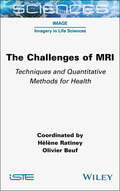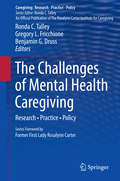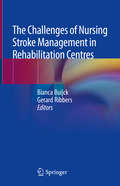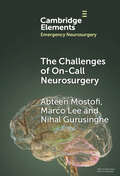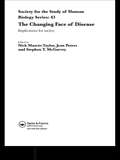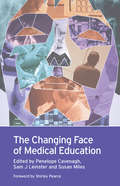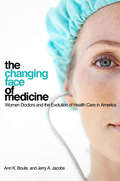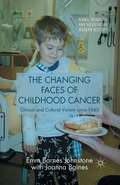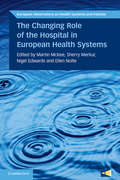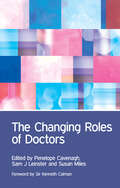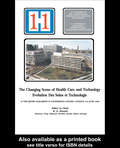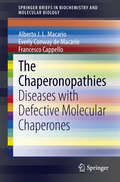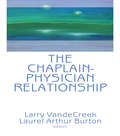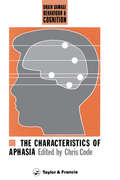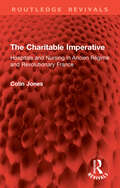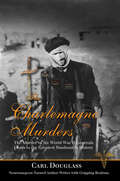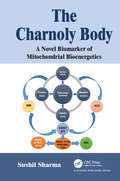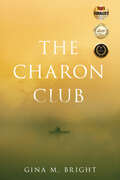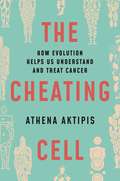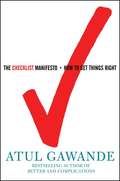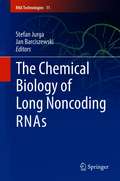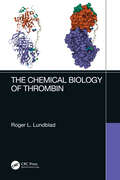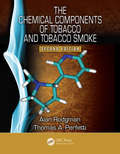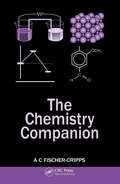- Table View
- List View
The Challenges of MRI: Techniques and Quantitative Methods for Health
by Olivier Beuf Hélène RatineyAfter a review of the essential concepts of magnetic resonance imaging (MRI), The Challenges of MRI presents the recent techniques and methods of MRI and resulting medical applications. These techniques provide access to information that goes well beyond anatomy, with functional, hemodynamic, structural, biomechanical and biochemical information. MRI allows us to probe living organisms in a multitude of ways, guaranteeing the potential for continuous development involving several disciplines: physics, electronics, life sciences, signal processing and medicine. This collective work is made up of chapters written and designed by experts from the French community. They have endeavored to describe the techniques by recalling the underlying physics and detailing the modeling, methods and strategies for acquiring or extracting information. This book is aimed at master’s students and PhD students, as well as lecturers and researchers in medical imaging and radiology.
The Challenges of Mental Health Caregiving
by Ronda C. Talley Gregory L. Fricchione Benjamin G. DrussCaring for the ill, disabled, very old, or very young requires a labor-intensive commitment that is not only essential to the well-being of individuals and to society as a whole, but also fraught with physical, financial, and psychological risks. And despite the critical nature of their job, caregivers rarely have avenues of support. The Challenges of Mental Health Caregiving addresses the complexities of the situation with uncommon depth and breadth. Suited to researchers, scientist-practitioners and clinicians, and students seeking a rounded understanding of the field, it examines how caregiving affects the lives, work, and mental health of family and professional caregivers. Chapters explore developmental, cultural, and spiritual contexts of care, addressing ongoing concerns about care in relation to larger health systems and emphasizing the need for care to be viewed as a community, rather than an individual or family experience. Further, the book's conclusion strongly advocates for more effective and efficient uses for available funds and resources while offering workable proposals for service improvements at the policy level. Key areas of coverage: The impact of caregiving on physical and mental health. Integrating mental health and primary care. The promotion of positive mental health outcomes in children and youth. Mid-life concerns and caregiver experience. Loss, grief, bereavement and the implications for mental health caregiving. Policy issues in caregiving and mental health. The Challenges of Mental Health Caregiving is a clear-sighted reference for researchers, clinicians and scientist-practitioners, and graduate students in the caregiving fields, including clinical psychology, social work, public health/medicine, geriatrics/gerontology, public policy, and educational policy.
The Challenges of Nursing Stroke Management in Rehabilitation Centres
by Bianca Buijck Gerard RibbersThis volume provides integral knowledge of all aspects of stroke care and rehabilitation after stroke, and is therefore highly relevant for nurses who work in rehabilitation centers. It outlines the several phases after stroke, for example the type of care patients may receive in the chronically phase at home. Nurses will obtain knowledge about treatment, importance of observation and caring with a special focus on communication problems, swallowing problems, activities of daily living, urinary and defecation problems, shoulder and hand issues. Thanks to photographs, nurses will learn to transfer patients in the adequate positions. Several chapters provide nurses with examples of effective and efficient collaboration with multidisciplinary professionals, informal caregivers and patients themselves. There is also an emphasis on behavior and cognitive functioning. And lastly, in the final chapters authors highlight the organization of rehabilitation and integrated care issues. Nurses play a very important role in rehabilitation, education, counseling, prevention, and caring for patients with cerebrovascular accident (CVA). In caring for stroke patients, nurses need specific competences and abilities that go beyond the general neurologic knowledge and experience. Nurses need to collaborate in an efficient and effective manner with multidisciplinary team members in their organization and across organizations. This book discusses medical aspects and specific symptoms of a stroke, as well as the limitations that patients experience, and which interventions are indicated for recovery.
The Challenges of On-Call Neurosurgery (Elements in Emergency Neurosurgery)
by Marco Lee Abteen Mostofi Nihal GurusingheOn-call neurosurgery concerns practice related to urgent and emergency neurosurgical care including outside of 'normal' working hours. Being on-call involves many competing responsibilities and is regarded as one of the most demanding aspects of a neurosurgical career. The on-call work pattern has evolved over the past decade due to changes in demographics, technology and working practices, each of which have brought new and emerging challenges. These challenges aside, the on-call provides a unique and rewarding environment to make a meaningful difference to patients and to learn the science and art of neurosurgery. Success in on-call work requires not only good technical knowledge and application but also a wide variety of non-technical skills. These skills will help deal with some of the difficult situations neurosurgeons in training face when on-call to make the experience more manageable and educational.
The Changing Face of Disease: Implications for Society (Society For The Study Of Human Biology Ser.)
by Nick Mascie-Taylor Jean Peters Stephen T. McGarveyDisease is an ever-present threat faced by all human societies. Today, this concept has become an influential area of study known as the global burden of disease, which encompasses contemporary health concerns such as the economic costs of disease, the societal impact of illness in developing nations, and infectious diseases resulting from lifestyl
The Changing Face of Medical Education (Radcliffe Ser.)
by Cavenagh Leinster PenelopeThe past 50 years - and even the past 20 years - have seen almost revolutionary change in medical education, which has emerged as a distinct discipline during that time. The curriculum to be covered, the most effective learning and teaching methods, and what kind of professional (and indeed person) medical education is intended to produce, how success can best be assessed and - not least - the make-up of students and teachers themselves have all changed enormously. This unique text draws together a wide variety of perspectives and focuses in particular on the experiences of one of the U.K.'s newer medical schools. It examines the key changes that have shaped the field, its practitioners and its students, presenting unique perspectives on both its history and on the current state of the art. This book is rewarding and informative reading for educationalists, academics, sociologists and researchers in medical history and education. 'The education of our healthcare professionals is one of the most important challenges for higher education. In setting up the new medical school at UEA we recognised this challenge and set out to develop a method of teaching and learning that put the student and their learning needs at the centre of the curriculum. The results of this and some of the developments that have emerged from those early days are outlined in this book.' - from the Foreword by Shirley Pearce
The Changing Face of Medicine: Women Doctors and the Evolution of Health Care in America
by Ann K. Boulis Jerry A. JacobsBoulis and Jacobs (sociology, U. of Pennsylvania) analyze from a sociological perspective the increase over recent decades of women who study and practice medicine in the US. They discuss specific issues that arise when female physicians meet the American health care system. Topics covered include: disparities of specialty and practice ownership, female physicians and family life, dual-physician marriages, specialty choice among female doctors, and whether or not they are changing the way medicine is practiced in the US, among others. ILR Pres is an imprint of Cornell U. Press. Annotation ©2009 Book News, Inc. , Portland, OR (booknews. com)
The Changing Faces of Childhood Cancer
by Emm Barnes JohnstoneThis book traces the development of British answers to the problem of childhood cancer. The establishment of the NHS and better training for paediatricians, meant children were given access to experimental chemotherapy, sending cure rates soaring. Children with cancer were thrust into the spotlight as individuals' stories of hope hit the headlines.
The Changing Role of the Hospital in European Health Systems (European Observatory on Health Systems and Policies)
by Ellen Nolte Sherry Merkur Martin McKee Nigel EdwardsHospitals today face a huge number of challenges, including new patterns of disease, rapidly evolving medical technologies, ageing populations and continuing budget constraints. This book is written by clinicians for clinicians and hospital managers, and those who design and operate hospitals. It sets out why hospitals need to change as the patients they treat and the technology to treat them changes. In a series of chapters by leading authorities in their field, it challenges existing models, reviews best practice from many countries and presents clear policy recommendations for policymakers and hospital administrators. It covers the main patient groups and conditions as well as those departments that make modern effective care possible, in imaging and laboratory medicine. Each chapter looks at patient pathways, aspects of workforce, required levels of specialisation and technology, and the opportunities and challenges for optimising the delivery of services in the hospital of the future. This title is also available as Open Access on Cambridge Core.
The Changing Roles of Doctors
by Amanda Howe Mick Collins Ann Barrett Penny Cavenagh Sam Leinster Veena Rodrigues Susanne Lindqvist Andrea Stockl Alistair LeinsterThis fascinating new book describes the evolution of the medical profession and how the role of the doctor and expectations of that role have changed over time. It critically examines developments in the light of both external influences such as the ageing population, patient attitudes and knowledge and government regulation, and internal changes such as the increasing knowledge base, advances in technology and changes in recruitment. Challenges in management, working environment, education and training are considered and practical recommendations for both practising and student doctors are offered. The holistic approach is supported with contributions from both primary and secondary care practitioners together with academics and educationalists. It is highly recommended for doctors and medical students seeking new strategies for understanding and managing change. Sociologists and policy makers, too, will find the wide-ranging perspectives enlightening.
The Changing Scene of Health Care and Technology: Proceedings of the 11th International Congress of Hospital Engineering, June 1990, London, UK
by R. G. KensettThis book provides an excellent opportunity to review developments in health care technology, many facets of which are just as applicable to professionals in the wider field of building services as to those working in health care facilities. This book reflects the adaptation of strategies in health care to economic and demographic change in both developed and developing countries.
The Changing Shape of Nursing Practice: The Role of Nurses in the Hospital Division of Labour
by Davina AllenBringing together sociological theories and nursing practice this text develops a dynamic conceptualisation of the nursing role which is rooted in the work setting. It looks at the factors which have shaped nursing work in the past and those which are likely to shape it in the future.Nurses' work is changing in two respects: the place nursing occupies in the health care division of labour and the routine shifting of work boundaries that nurses experience in their daily work. Drawing on her detailed observations of the reality of nursing work in a district general hospital, Davina Allen explores these linked themes, focussing on five key work boundaries:*nurse:doctor *nurse:manager*nurse:support worker*nurse:patient*nurse:nurseThe text provides new insight into many of the tensions and dilemmas nurses routinely face and the processes and constraints through which their work is fashioned. It offers a new way of thinking about the nursing role which is particularly relevant at a time when the scope of nursing practice is expanding and when the integrated approach to health and social care is seen as the key to provision and improved services.
The Chaperonopathies
by Francesco Cappello Everly Conway de Macario Alberto J.L. MacarioThis Brief provides a concise review of chaperonopathies, i.e., diseases in which molecular chaperones play an etiologic-pathogenic role. Introductory chapters deal with the chaperoning system and chaperoning teams and networks, HSP-chaperone subpopulations, the locations and functions of chaperones, and chaperone genes in humans. Other chapters present the chaperonopathies in general, including their molecular features and mechanistic classification into by defect, excess, or mistake. Subsequent chapters discuss the chaperonopathies in more detail, focusing on their distinctive characteristics: primary or secondary; quantitative and/or qualitative; structural and hereditary or acquired; genetic polymorphisms; gene dysregulation; age-related; associated with cancer, chronic inflammatory conditions, and autoimmune diseases. The interconnections between the chaperoning and the immune systems in cancer development, chronic inflammation, autoimmunity, and ageing are outlined, which leads to a discussion on the future prospects of chaperonotherapy. The latter may consist of chaperone gene and protein replacement/supplementation in cases of deficiency and of gene or protein blocking when the chaperone actively promotes disease. The last chapter presents the extracellular chaperones and details on how the chaperone Hsp60 is secreted into the extracellular space and, thus, appears in the blood of cancer patients with potential to participate in carcinogenesis and chronic inflammation and autoimmunity. Chaperones as clinically useful biomarkers are mentioned when pertinent. Likewise, guidelines for clinical evaluation of chaperonopathies and for their histopathological and molecular identification are provided throughout. The book also provides extensive bibliography organized by chapter and topic with comments.
The Chaplain-Physician Relationship
by Larry Van De CreekLearn how to establish and maintain effective relationships with physicians with this authoritative new book. Chaplains will discover a wealth of information and insight into the often strained chaplain-physician relationship and will learn practical steps they can take to strengthen the ties between two very different professions. Each chapter, written by a chaplain with a history of successful collaboration with physicians, features important examples of interdisciplinary cooperative effort in various settings including obstetrics, geriatrics, and outpatient cardiac rehabilitation centers. Hospital chaplains, especially those who wish to improve their relationships with physicians and hospital administrators will find this to be an invaluable book, as will pastoral counselors not presently involved with hospitals who desire to work with physicians in health and illness settings.Highlights of the book include: an inside view of medical education and practice, with a description of the dilemmas of medical practice which are very different from those in ministry A constructive look at “doctor bashing” in which many chaplains engage, often unknowingly a description of pastoral care efforts in discrete patient care areas that involve close relationships to physicians, with an emphasis on friendship and informal contacts an overview of a program in which the chaplains’s role is expanded to that of a behavioral medicine consultant
The Characteristics Of Aphasia (Brain, Behaviour and Cognition)
by Chris CodeA survey of the main behavioural characteristics or symptoms of aphasia, which presents a series of essays on the history and current developments in this field of neuropsychological research. Contributors discuss recovery, rehabilitation and other contemporary issues.
The Charitable Imperative: Hospitals and Nursing in Ancien Régime and Revolutionary France (Routledge Revivals)
by Colin JonesDrawing on a wide variety of archival and secondary sources, The Charitable Imperative, originally published in 1989, provides an overview of the very different institutions that treated the poor in France from the seventeenth through to the early nineteenth centuries: hospitals and poorhouses, military infirmaries, reformatories for prostitutes, holding places for the insane, and so on. It recovers much of the daily realities of the institutions for those who lived in or passed through them and highlights the very limited progress made in most of them by the medical profession.The principle of charity which underpinned this system of relief placed moral and social obligations on all who dealt with the poor: a kind of charitable imperative affected the thinking and behaviour of the administrators who managed the institutions, the nursing sisters who gave their lives, and the donors who gave up their possessions to meet the needs of the poor. However, the poor were also expected to pay their part, with the result that the Ancien Régime charity subsumed compulsion and repression as well as compassion. In spite of efforts to introduce a state-sponsored welfare system during the French Revolution, the charitable imperative was a legacy of the Ancien Régime to much of the nineteenth century.The breadth of institutions covered, and the length of the historical period under review, will ensure the appeal of this book to a wide variety of historians. In particular, the chapters on nursing sisters will be of great interest to social historians as well as those working in the history of medicine.
The Charlemagne Murders: The Murder of Six World War II Generals Leads to the Greatest Manhunt in History
by Douglass CarlSix famous (or infamous, if you prefer) World War Two generals have been murdered in six different countries leading to separate quiet but intense investigations. INTERPOL is finally involved because the police in each country come to realize that there has to be a connection, but no one knows what that connection is. Once links seem plausible, the Mossad joins the international police investigation and search; and the greatest manhunt in history is launched spreading over four continents and delving into secrets best left undisturbed.
The Charnoly Body: A Novel Biomarker of Mitochondrial Bioenergetics
by Sushil SharmaDiversified physicochemical injuries trigger Charnoly body (CB) formation as pleomorphic, electron-dense, multi-lamellar stacks of nonfunctional mitochondrial membranes in the most vulnerable cell. Free radicals induce downregulation of mitochondrial DNA, microRNA, AgNOR, and epigenetics to trigger CB molecular pathogenesis. CB is eliminated by energy (ATP)-driven lysosome-dependent charnolophagy as a basic molecular mechanism of intracellular detoxification to prevent acute and chronic diseases. Accumulation of CB at the junction of axon hillock and charnolosome (CS) at the synapses causes cognitive impairments; whereas, nonspecific induction of CB causes GIT stress, myelosuppression, alopecia, neurotoxicity, cardiotoxicity, and infertility in multidrug-resistant malignancies. Hence, stem cell-specific CB, charnolophagy, and CS agonists/antagonists are introduced as novel charnolopharmacotherapeutics for the successful treatment of cardiovascular diseases, neurodegenerative diseases, infectious diseases, drug addiction, and cancer. Nanoparticles to improve drug delivery, CS exocytosis, and disease-specific spatiotemporal charnolosomics employing correlative and combinatorial bioinformatics boost mitochondrial bioenergetics through balanced diet, exercise, and antioxidants. The book will be of interest to medical scientists and practitioners.
The Charon Club
by Gina BrightThe AIDS Quilt will be on display in June 2021 for the 40th anniversary of the first cases, but it will be its last appearance as ordered by the heavy hand of the President of the United States. Nine nurses who worked with AIDS patients during the early years of the pandemic travel to Washington, D.C. to see the Quilt. While there, they are called upon by the National Health Center to care for patients with a new, unknown infectious disease and racist views, and they are asked to find the clues to its cause so that a VIP patient can be cured. But the nurses discover that even more challenging than this difficult assignment are the memories they begin to share from their painful AIDS nursing past. The Charon Club, a fictional chronicle of AIDS nurses' memories and experiences, set in the midst of an emerging infectious disease in the eastern United States in 2021, was written by a nurse who worked on an AIDS unit in New York City during the darkest years of the pandemic. It is the first AIDS novel solely devoted to the work of nurses.
The Cheating Cell: How Evolution Helps Us Understand and Treat Cancer
by Athena AktipisA fundamental and groundbreaking reassessment of how we view and manage cancer When we think of the forces driving cancer, we don’t necessarily think of evolution. But evolution and cancer are closely linked, for the historical processes that created life also created cancer. The Cheating Cell delves into this extraordinary relationship, and shows that by understanding cancer’s evolutionary origins, researchers can come up with more effective, revolutionary treatments.Athena Aktipis goes back billions of years to explore when unicellular forms became multicellular organisms. Within these bodies of cooperating cells, cheating ones arose, overusing resources and replicating out of control, giving rise to cancer. Aktipis illustrates how evolution has paved the way for cancer’s ubiquity, and why it will exist as long as multicellular life does. Even so, she argues, this doesn’t mean we should give up on treating cancer—in fact, evolutionary approaches offer new and promising options for the disease’s prevention and treatments that aim at long-term management rather than simple eradication. Looking across species—from sponges and cacti to dogs and elephants—we are discovering new mechanisms of tumor suppression and the many ways that multicellular life-forms have evolved to keep cancer under control. By accepting that cancer is a part of our biological past, present, and future—and that we cannot win a war against evolution—treatments can become smarter, more strategic, and more humane.Unifying the latest research from biology, ecology, medicine, and social science, The Cheating Cell challenges us to rethink cancer’s fundamental nature and our relationship to it.
The Checklist Manifesto: How to Get Things Right
by Atul GawandeThe New York Times bestselling author of Better and Complications reveals the surprising power of the ordinary checklist. We live in a world of great and increasing complexity, where even the most expert professionals struggle to master the tasks they face. Longer training, ever more advanced technologies-- neither seems to prevent grievous errors. But in a hopeful turn, acclaimed surgeon and writer Atul Gawande finds a remedy in the humblest and simplest of techniques: the checklist. First introduced decades ago by the U.S. Air Force, checklists have enabled pilots to fly aircraft of mind-boggling sophistication. Now innovative checklists are being adopted in hospitals around the world, helping doctors and nurses respond to everything from flu epidemics to avalanches. Even in the immensely complex world of surgery, a simple ninety-second variant has cut the rate of fatalities by more than a third. In riveting stories, Gawande takes us from Austria, where an emergency checklist saved a drowning victim who had spent half an hour underwater, to Michigan, where a cleanliness checklist in intensive care units virtually eliminated a type of deadly hospital infection. He explains how checklists actually work to prompt striking and immediate improvements. And he follows the checklist revolution into fields well beyond medicine, from disaster response to investment banking, skyscraper construction, and businesses of all kinds. An intellectual adventure in which lives are lost and saved and one simple idea makes a tremendous difference, The Checklist Manifesto is essential reading for anyone working to get things right.
The Chemical Biology of Long Noncoding RNAs (RNA Technologies #11)
by Jan Barciszewski Stefan JurgaThis book offers a comprehensive and detailed overview of various aspects of long non-coding RNAs. It discusses their emerging significance in molecular medicine, ranging from human cancers to cardiovascular and metabolic diseases. Transcriptomic studies have demonstrated that the majority of genomes found in complex organisms are expressed in highly dynamic and cell-specific patterns, producing huge numbers of intergenic, antisense and intronic long non-protein-coding RNAs (lncRNAs). Thousands of lncRNAs have been identified, and unlike mRNA, they have no protein-coding capacity. A large repertoire of ncRNAs, actively transcribed from the mammalian genome, control diverse cellular processes, both in terms of development and diseases, through a variety of gene regulatory mechanisms. IncRNAs have emerged as a new paradigm in epigenetic regulation of the genome. Given its scope, the book will be of particular interest to molecular, chemical, cell and developmental biologists, as well as specialists in translational medicine involved in disease-oriented research. It also offers a valuable resource for in silico experts seeking a deeper understanding of lncRNA expression and function through computational analysis of the NGS data.
The Chemical Biology of Thrombin
by Roger L. LundbladThis book is a comprehensive review of thrombin, especially as regulatory protease. The ready availability of highly purified thrombin has stimulated rapid advances in the cell biology of this important macromolecule. The text focuses on research findings from the discovery of thrombin by Andrew Buchanan in 1842 to the present. A substantial amount of this work was conducted by the author and his colleagues. His work on the purification of thrombin was seminal to much subsequent work on thrombin. This volume provides a framework for future studies now made possible by the discovery of the importance of exosites in the physiology of thrombin function. The current work describes the process of the development of an oral inhibitor of thrombin used in the prevention of thrombosis. Key Features Reviews the history of Thrombin (Fibrin Ferment) Documents the relation of protein engineering and chemical modification in the study of thrombin Summarizes the interaction of thrombin with fibrinogen and fibrin Outlines the role of exosites in thrombin function Describes the development of an oral inhibitor for thrombin
The Chemical Components of Tobacco and Tobacco Smoke
by Alan Rodgman Thomas A. PerfettiAuthored by two longtime researchers in tobacco science, The Chemical Components of Tobacco and Tobacco Smoke, Second Edition chronicles the progress made from late 2008 through 2011 by scientists in the field of tobacco science. The book examines the isolation and characterization of each component. It explores developments in pertinent analytical
The Chemistry Companion
by Anthony C. Fischer-CrippsLike the author's other companion books, The Chemistry Companion provides-high quality information in unique one-page-per-topic presentations that do not overburden and distract with excessive details. The book offers concise summaries of general chemistry concepts, easily accessible in a convenient, reader-friendly format.Suitable as an introducti
